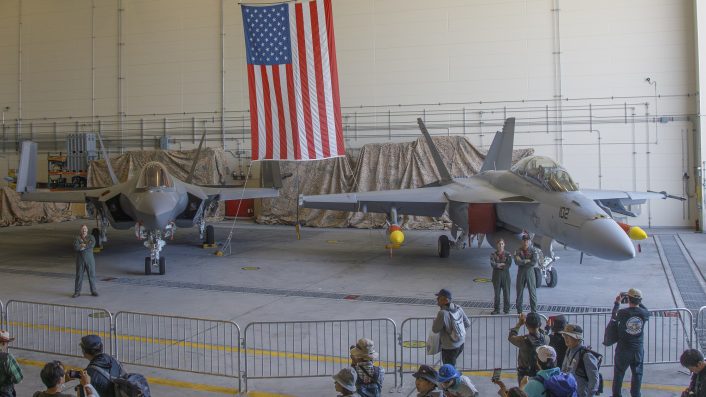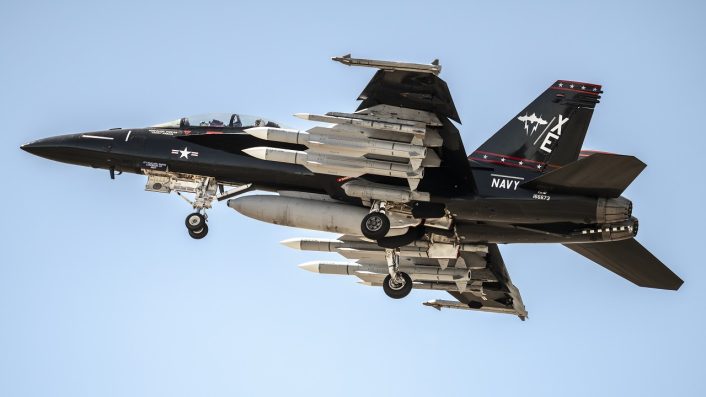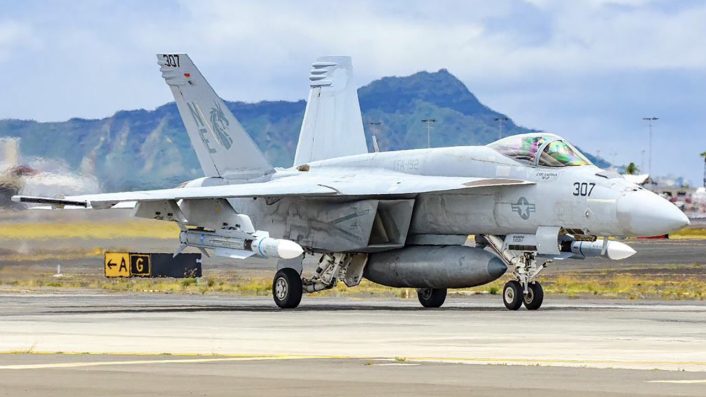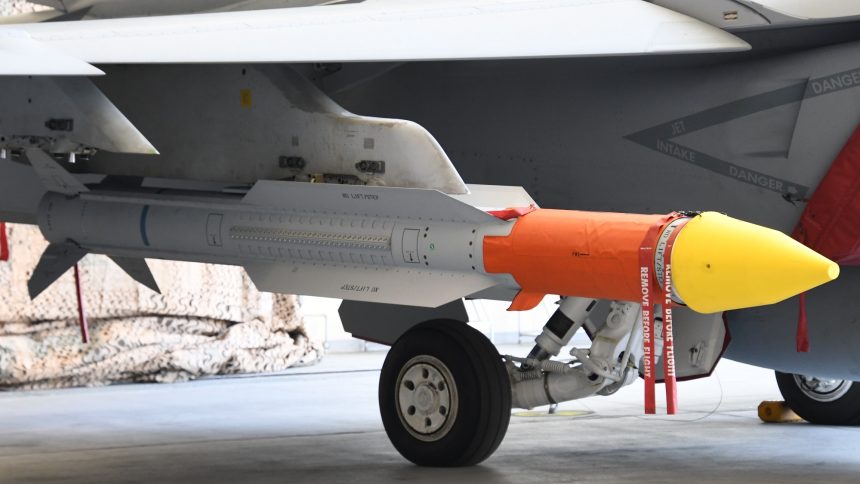The AIM-174B, also known as the Standard Missile 6 Air Launched Configuration, received the new nickname in the recent Naval Aviation Playbook 2025.
Almost a year after it was introduced in service, the AIM-174B long-range missile has now been officially nicknamed “Gunslinger.” The name was included among the new capabilities listed for the F/A-18 Super Hornet in the Naval Aviation Playbook 2025 by the Commander, Naval Air Forces Vice Admiral Daniel L. Cheever.
The newest air-to-air weapon of the U.S. Navy has also been recently shown during the Japan Maritime Self-Defense Force-Marine Corps Air Station Iwakuni Friendship Day in early May. Initially seen on Super Hornets assigned to Carrier Air Wing (CVW) 2 during RIMPAC 2024, the AIM-174 has now been delivered to CVW 5 which is based at MCAS Iwakuni.
The Naval Aviation Playbook 2025 provides a brief three-point description of the weapon:
GUNSLINGER AIM-174B
- The AIM-174B is a long-range, air-to-air missile also known as the SM-6.
- This missile allows F/A-18E/F Super Hornets to engage adversary aircraft at extended distances.
- It represents the first dedicated long-range, air-to-air missile employed by the U.S. Navy since the retirement of the AIM-54 Phoenix in 2004, marking a significant advancement in Naval Aviation combat capabilities.
As mentioned in this description, the AIM-174B is a variant of the Standard Missile (SM) 6, and specifically the SM-6 Air Launched Configuration (ALC). It is still unclear what type of modifications have been made to the AIM-174B compared to the SM-6, but one readily visible is the absence of the Mk72 booster used by the SM-6 during the launch from the Mark 41 vertical launching system (Mk 41 VLS).
In the Test & Evaluation Oversight List, the Director, Operational Test & Evaluation (DOT&E) reported that the SM-6 ALC is currently involved in the Operational Testing (OT) and Live Fire (LF) activities, having completed Developmental Testing (DT). The U.S. Navy confirmed in July 2024 that the weapon in operationally deployed.

AIM-174B
As we’ve detailed in recent months, the AIM-174B missile is a variant of the Standard Missile 6 (SM-6) repurposed for air-to-air engagements. Originally designed as the RIM-174 Standard Extended Range Active Missile (ERAM), the SM-6 serves as the U.S. Navy’s primary long-range anti-air and anti-missile defense solution, integrated with the Aegis Combat System on Navy vessels.
The SM-6 ERAM is a key asset in the Navy’s long-range air defense strategy. Derived from the RIM-156A SM-2ER Block IV airframe and equipped with an active radar seeker from the AIM-120 AMRAAM, the SM-6 is capable of reaching Mach 3.5 and has a range of 200 nautical miles in its ship-based form.
While traditionally ship-launched, the SM-6 has been tested in air-launched configurations as early as 2018 and again in 2021 on other VX-31 Super Hornets, but only this year has its deployment accelerated, with further involvement from operational units.
In April 2024, an F/A-18 was spotted carrying the AIM-174, then, on Jul. 2, 2024, an F/A-18E Super Hornet belonging to the VFA-192 “Golden Dragons” was photographed taxiing at Joint Base Pearl Harbor-Hickam, Hawaii, carrying two AIM-174B missiles marking the first appearance of the missile on a frontline platform during RIMPAC 2024. At the beginning of September, images of VX-9’s Super Hornet carrying four AIM-174s mounted on both inner and middle hardpoints, along with AIM-120s set a new benchmark for its air-to-air load capacity. Additionally, the ASG-34A IRST integrated on the fuel tank complemented the Super Hornet’s radar, providing advanced tracking capability in electronic warfare or radar-denied settings.
While details on the air-launched AIM-174B’s maximum range remain unclear, it is likely to exceed the surface-launched version when launched at altitude and speed, positioning it among the longest-range air-to-air weapons in the U.S. inventory and filling the void left by the retirement of the AIM-54 Phoenix.

Operationally deployed
Officially acknowledged in July 2024 as operationally deployed with CVW-2 aboard the USS Carl Vinson, the AIM-174B’s availability in IOC (Initial Operating Capability) extends the U.S. Navy’s reach in long-range engagement. Although publicly seen with only inert and training versions, live missiles are likely already available in the fleet.
As shown by its appearance in the JMSDF-MCAS Iwakuni Friendship Day, the AIM-174 has now been fielded also with CVW-5 assigned to the USS George Washington (CVN 73). This is notable as they are the only permanently forward-deployed air wing and the only permanently forward-deployed aircraft carrier, respectively, and they are on China’s doorstep.
The long-range AAM is considered to be intended for a possible fight in the Pacific theatre, where it would overcome some of the restrictions caused by China’s anti-access capabilities. Such a weapon would allow to reach critical assets, such as AEW&C and ISR aircraft which would work under the protection of long-range air defenses.

As we explained in a previous post:
With the induction of the AIM-174B into service, the U.S. Navy joins a number of air arms capable of deploying an extra-long-range beyond-visual-range air-to-air missile (BVRAAM), like the MBDA Meteor, the Russian R-37M and Chinese PL-15 and PL-21. In fact, the AIM-174B enables the U.S. Navy Super Hornets to engage targets at much greater distances than is currently possible with the AIM-120 AMRAAM. Integrated with the E-2D, F-35, and AEGIS within the Naval Integrated Fire Control-Counter Air (NIFC-CA) system, the AIM-174B would extend the Navy’s capability to intercept aerial targets at ranges comparable to (if not greater than) those achieved against naval targets using the baseline SM-6.
In essence, this new missile fills the gap left by the retirement of the AIM-54 Phoenix. The AIM-54 was a long-range air-to-air missile used by the U.S. Navy’s F-14 Tomcat and retired in 2004 alongside the F-14. Known for its impressive range of over 100 nautical miles and multiple-target engagement capability, the AIM-54 left a significant void in long-range engagement capabilities.
While there wasn’t a direct replacement for the AIM-54 Phoenix in terms of range, the U.S. military has been developing advanced air-to-air missiles to enhance its fighter aircraft capabilities.









